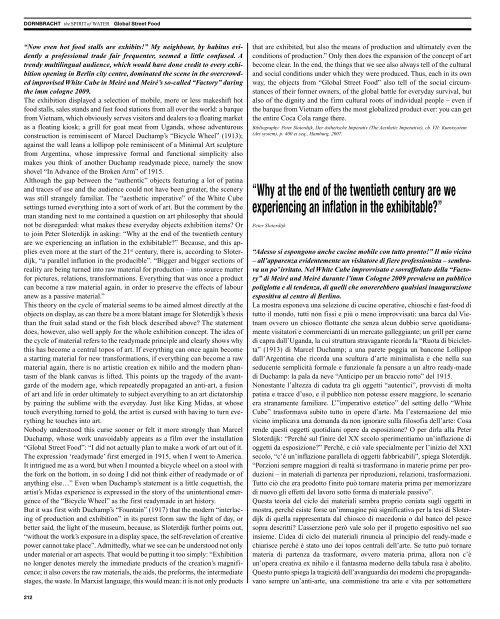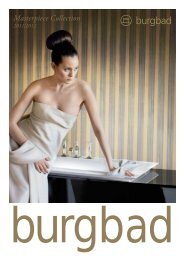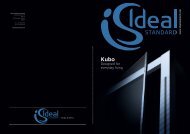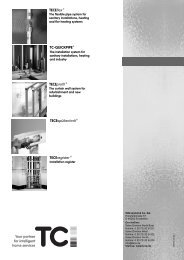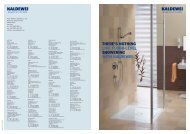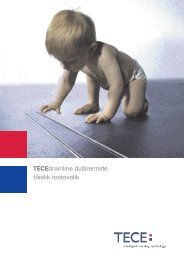productos Dornbracht
productos Dornbracht
productos Dornbracht
You also want an ePaper? Increase the reach of your titles
YUMPU automatically turns print PDFs into web optimized ePapers that Google loves.
DORNBRACHT the SPIRITof WATER Global Street Food<br />
DORNBRACHT the SPIRITof WATER Global Street Food<br />
“Now even hot food stalls are exhibits!” My neighbour, by habitus evidently<br />
a professional trade fair frequenter, seemed a little confused. A<br />
trendy multilingual audience, which would have done credit to every exhibition<br />
opening in Berlin city centre, dominated the scene in the overcrowded<br />
improvised White Cube in Meiré und Meiré’s so-called “Factory” during<br />
the imm cologne 2009.<br />
The exhibition displayed a selection of mobile, more or less makeshift hot<br />
food stalls, sales stands and fast food stations from all over the world: a barque<br />
from Vietnam, which obviously serves visitors and dealers to a floating market<br />
as a floating kiosk; a grill for goat meat from Uganda, whose adventurous<br />
construction is reminiscent of Marcel Duchamp’s “Bicycle Wheel” (1913);<br />
against the wall leans a lollipop pole reminiscent of a Minimal Art sculpture<br />
from Argentina, whose impressive formal and functional simplicity also<br />
makes you think of another Duchamp readymade piece, namely the snow<br />
shovel “In Advance of the Broken Arm” of 1915.<br />
Although the gap between the “authentic” objects featuring a lot of patina<br />
and traces of use and the audience could not have been greater, the scenery<br />
was still strangely familiar. The “aesthetic imperative” of the White Cube<br />
settings turned everything into a sort of work of art. But the comment by the<br />
man standing next to me contained a question on art philosophy that should<br />
not be disregarded: what makes these everyday objects exhibition items? Or<br />
to join Peter Sloterdijk in asking: “Why at the end of the twentieth century<br />
are we experiencing an inflation in the exhibitable?” Because, and this applies<br />
even more at the start of the 21 st century, there is, according to Sloterdijk,<br />
“a parallel inflation in the producible”. “Bigger and bigger sections of<br />
reality are being turned into raw material for production – into source matter<br />
for pictures, relations, transformations. Everything that was once a product<br />
can become a raw material again, in order to preserve the effects of labour<br />
anew as a passive material.”<br />
This theory on the cycle of material seems to be aimed almost directly at the<br />
objects on display, as can there be a more blatant image for Sloterdijk’s thesis<br />
than the fruit salad stand or the fish block described above? The statement<br />
does, however, also well apply for the whole exhibition concept. The idea of<br />
the cycle of material refers to the readymade principle and clearly shows why<br />
this has become a central topos of art. If everything can once again become<br />
a starting material for new transformations, if everything can become a raw<br />
material again, there is no artistic creation ex nihilo and the modern phantasm<br />
of the blank canvas is lifted. This points up the tragedy of the avantgarde<br />
of the modern age, which repeatedly propagated an anti-art, a fusion<br />
of art and life in order ultimately to subject everything to an art dictatorship<br />
by pairing the sublime with the everyday. Just like King Midas, at whose<br />
touch everything turned to gold, the artist is cursed with having to turn everything<br />
he touches into art.<br />
Nobody understood this curse sooner or felt it more strongly than Marcel<br />
Duchamp, whose work unavoidably appears as a film over the installation<br />
“Global Street Food”: “I did not actually plan to make a work of art out of it.<br />
The expression ‘readymade’ first emerged in 1915, when I went to America.<br />
It intrigued me as a word, but when I mounted a bicycle wheel on a stool with<br />
the fork on the bottom, in so doing I did not think either of readymade or of<br />
anything else…” Even when Duchamp’s statement is a little coquettish, the<br />
artist’s Midas experience is expressed in the story of the unintentional emergence<br />
of the “Bicycle Wheel” as the first readymade in art history.<br />
But it was first with Duchamp’s “Fountain” (1917) that the modern “interlacing<br />
of production and exhibition” in its purest form saw the light of day, or<br />
better said, the light of the museum, because, as Sloterdijk further points out,<br />
“without the work’s exposure in a display space, the self-revelation of creative<br />
power cannot take place”. Admittedly, what we see can be understood not only<br />
under material or art aspects. That would be putting it too simply: “Exhibition<br />
no longer denotes merely the immediate products of the creation’s magnificence;<br />
it also covers the raw materials, the aids, the preforms, the intermediate<br />
stages, the waste. In Marxist language, this would mean: it is not only products<br />
that are exhibited, but also the means of production and ultimately even the<br />
conditions of production.” Only then does the expansion of the concept of art<br />
become clear. In the end, the things that we see also always tell of the cultural<br />
and social conditions under which they were produced. Thus, each in its own<br />
way, the objects from “Global Street Food” also tell of the social circumstances<br />
of their former owners, of the global battle for everyday survival, but<br />
also of the dignity and the firm cultural roots of individual people – even if<br />
the barque from Vietnam offers the most globalized product ever: you can get<br />
the entire Coca Cola range there.<br />
Bibliography: Peter Sloterdijk, Der ästhetische Imperativ (The Aesthetic Imperative), ch. VII: Kunstsystem<br />
(Art system), p. 400 et seq., Hamburg, 2007.<br />
“Why at the end of the twentieth century are we<br />
experiencing an inflation in the exhibitable?”<br />
Peter Sloterdijk<br />
“Adesso si espongono anche cucine mobile con tutto pronto!” Il mio vicino<br />
– all’apparenza evidentemente un visitatore di fiere professionista – sembrava<br />
un po’ irritato. Nel White Cube improvvisato e sovraffollato della “Factory”<br />
di Meiré und Meiré durante l’imm Cologne 2009 prevaleva un pubblico<br />
poliglotta e di tendenza, di quelli che onorerebbero qualsiasi inaugurazione<br />
espositiva al centro di Berlino.<br />
La mostra esponeva una selezione di cucine operative, chioschi e fast-food di<br />
tutto il mondo, tutti non fissi e più o meno improvvisati: una barca dal Vietnam<br />
ovvero un chiosco flottante che senza alcun dubbio serve quotidianamente<br />
visitatori e commercianti di un mercato galleggiante; un grill per carne<br />
di capra dall’Uganda, la cui struttura stravagante ricorda la “Ruota di bicicletta”<br />
(1913) di Marcel Duchamp; a una parete poggia un bancone Lollipop<br />
dall’Argentina che ricorda una scultura d’arte minimalista e che nella sua<br />
seducente semplicità formale e funzionale fa pensare a un altro ready-made<br />
di Duchamp: la pala da neve “Anticipo per un braccio rotto” del 1915.<br />
Nonostante l’altezza di caduta tra gli oggetti “autentici”, provvisti di molta<br />
patina e tracce d’uso, e il pubblico non potesse essere maggiore, lo scenario<br />
era stranamente familiare. L’”imperativo estetico” del setting dello “White<br />
Cube” trasformava subito tutto in opere d’arte. Ma l’esternazione del mio<br />
vicino implicava una domanda da non ignorare sulla filosofia dell’arte: Cosa<br />
rende questi oggetti quotidiani opere da esposizione? O per dirla alla Peter<br />
Sloterdijk: “Perché sul finire del XX secolo sperimentiamo un’inflazione di<br />
oggetti da esposizione?” Perché, e ciò vale specialmente per l’inizio del XXI<br />
secolo, “c’è un’inflazione parallela di oggetti fabbricabili”, spiega Sloterdijk.<br />
“Porzioni sempre maggiori di realtà si trasformano in materie prime per produzioni<br />
– in materiali di partenza per riproduzioni, relazioni, trasformazioni.<br />
Tutto ciò che era prodotto finito può tornare materia prima per memorizzare<br />
di nuovo gli effetti del lavoro sotto forma di materiale passivo”.<br />
Questa teoria del ciclo dei materiali sembra proprio coniata sugli oggetti in<br />
mostra, perché esiste forse un’immagine più significativa per la tesi di Sloterdijk<br />
di quella rappresentata dal chiosco di macedonia o dal banco del pesce<br />
sopra descritti? L’asserzione però vale solo per il progetto espositivo nel suo<br />
insieme. L’idea di ciclo dei materiali rinuncia al principio del ready-made e<br />
chiarisce perché è stato uno dei topos centrali dell’arte. Se tutto può tornare<br />
materia di partenza da trasformare, ovvero materia prima, allora non c’è<br />
un’opera creativa ex nihilo e il fantasma moderno della tabula rasa è abolito.<br />
Questo punto spiega la tragicità dell’avanguardia dei moderni che propagandavano<br />
sempre un’anti-arte, una commistione tra arte e vita per sottomettere<br />
Global Street Food, imm international furniture fair / Passagen, Cologne 2009<br />
“Floating market”, Ho Chi Minh City, Vietman / “Fruit salad stand”, Buenos Aires, Argentina / “Cheese and sausage stand”, Buenos Aires, Argentina<br />
212<br />
213


